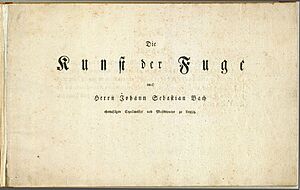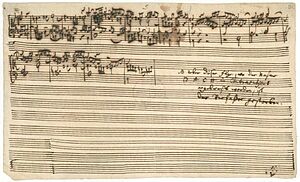The Art of Fugue facts for kids
The Art of Fugue (in German, Die Kunst der Fuge), also known as The Art of the Fugue, is a famous musical work by Johann Sebastian Bach. It's listed as BWV 1080. Bach wrote this piece in the last ten years of his life. It's special because it shows how much Bach explored music that uses one main tune or idea.
This work has fourteen fugues and four canons. They are all in the key of D minor. Each piece uses a different version of the same main musical idea, called a subject. The pieces are usually arranged from simple to more complex. Bach wanted to explore all the ways he could use one musical subject in contrapuntal music. "Contrapunctus" is often used as the name for each fugue in this collection.
Contents
What is The Art of Fugue's Structure?
The Art of Fugue is built around one main musical idea. Every canon and fugue uses a different version of this idea. The work is divided into seven groups. Each group uses a specific musical technique. In the 1751 printed edition, these groups become more complex as you go through them.
Simple Fugues
These are basic four-voice fugues:
- Contrapunctus 1: A four-voice fugue using the main subject.
- Contrapunctus 2: Another four-voice fugue. It uses the main subject with a "French" style dotted rhythm.
- Contrapunctus 3: A four-voice fugue. It uses the main subject played upside down (inversion). It also has many chromatic notes.
- Contrapunctus 4: A four-voice fugue. It uses the main subject upside down and adds other melodies called counter-subjects.
Stretto Fugues (Counter-Fugues)
In these fugues, the main subject is used in many ways at the same time. It can be regular, upside down, stretched out, or shortened.
- Contrapunctus 5: This piece has many stretto entries. This means the musical ideas overlap closely.
- Contrapunctus 6, a 4 in Stylo Francese: This fugue adds the theme in a shortened form (diminution). It also has quick, small groups of notes. These elements, along with the dotted rhythm, give it a "French style."
- Contrapunctus 7, a 4 per Augment[ationem] et Diminut[ionem]: This piece uses the main subject in a stretched-out version (augmented) and a shortened version (diminished). It also uses the upside-down version.
Double and Triple Fugues
These fugues use two or three main subjects.
- Contrapunctus 8, a 3: This is a triple fugue with three subjects. Each subject is introduced on its own.
- Contrapunctus 9, a 4, alla Duodecima: This is a double fugue. It has two subjects that work together and can be played upside down at a specific musical interval (a twelfth).
- Contrapunctus 10, a 4, alla Decima: Another double fugue. Its two subjects work together and can be played upside down at a different interval (a tenth).
- Contrapunctus 11, a 4: A triple fugue. It uses the three subjects from Contrapunctus 8 but all played upside down.
Mirror Fugues
In these special fugues, the music is written once. Then, it can be played completely upside down, with all the voices reversed. It still sounds correct and musical.
- Contrapunctus inversus 12 a 4 (in both normal and inverted forms)
- Contrapunctus inversus 13 a 3 (in both normal and inverted forms)
Canons
These pieces are called canons. They are named by the musical interval and technique used. A canon is like a round, where one voice starts a melody and another voice copies it.
- Canon per Augmentationem in Contrario Motu: In this canon, the second voice plays the melody upside down and stretched out (augmented).
- Canon alla Ottava: A canon where the second voice copies the first at the interval of an octave.
- Canon alla Decima [in] Contrapunto alla Terza: A canon where the second voice copies the first at the interval of a tenth.
- Canon alla Duodecima in Contrapunto alla Quinta: A canon where the second voice copies the first at the interval of a twelfth.
Other Versions
- Contra[punctus] a 4: This is a different version of the last part of Contrapunctus 10.
- Fuga a 2 Clav: and Alio modo. Fuga a 2 Clav.: These are versions of Contrapunctus inversus a 3 arranged for two keyboards.
The Unfinished Fugue
- [Contrapunctus 14] Fuga a 3 Soggetti: This is a four-voice triple fugue. Bach did not finish it. It was likely meant to become a quadruple fugue (with four subjects). The third subject starts with the famous BACH motif, which spells out Bach's name in musical notes (B-flat, A, C, B-natural).
What Instruments Play The Art of Fugue?
Both versions of The Art of Fugue are written in open score. This means each musical voice has its own separate line of music. Because of this, some people thought the work was just for studying, not for playing.
However, many experts now believe it was meant for a keyboard instrument. The famous harpsichord player Gustav Leonhardt argued that it was written for the harpsichord. Here are some of his reasons:
- In Bach's time, it was common to publish complex keyboard pieces in open score.
- The musical range of the voices in The Art of Fugue doesn't match any orchestra instruments of that time. Also, it doesn't have the typical melodies Bach wrote for groups of instruments. There's no basso continuo (a continuous bass line).
- The types of fugues used are similar to those in Bach's other keyboard work, The Well-Tempered Clavier.
- The bass part sometimes goes above the tenor part. This suggests it wasn't meant for an instrument like the pipe organ that doubles notes at a very low pitch. This makes the harpsichord the most likely choice.
Today, most scholars agree that Bach intended this work to be played on a keyboard instrument.
The Unfinished Fuga a 3 Soggetti
Fuga a 3 Soggetti (meaning "fugue in three subjects") is also known as the "Unfinished Fugue" or Contrapunctus 14. It was found in a handwritten manuscript. The music stops suddenly in the middle of measure 239.
Bach's son, Carl Philipp Emanuel Bach, wrote a note on this manuscript. It said, "While working on this fugue, which introduces the name BACH in the countersubject, the composer died." However, modern scholars don't fully agree with this. The handwriting shows it was written by Bach himself. This means it was likely written before his health and eyesight got very bad, probably around 1748–1749.
Who Tried to Finish It?
Many musicians and music experts have tried to complete Contrapunctus XIV. They often add a fourth subject to the fugue. Some of these people include:
- Musicologists like Donald Tovey and Zoltán Göncz.
- Organists such as Helmut Walcha and Davitt Moroney.
- Conductors like Rudolf Barshai.
- Pianist Daniil Trifonov.
Why is The Art of Fugue Important?
How it's Built
Some researchers have found a mathematical structure in The Art of Fugue. They believe it might be based on the Fibonacci series and the golden ratio when looking at the number of musical bars.
One idea is that Bach used "opposition" to create variety in the first few Contrapuncti. This means he changed things like:
- The direction of the melody (playing it upside down).
- How the different voices interact (contrapuntal inversion).
- The musical harmony (using dissonance).
- How busy the music sounds (texture).
- The rhythm (using syncopation).
- The musical key (modulation).
For example, Contrapuncti 1 and 2 often switch between the keys of A minor and D minor. This shows how Bach made the music change and grow over time.
The Unfinished Contrapunctus 14
A musician named Indra Hughes suggested in 2007 that Bach didn't leave Contrapunctus 14 unfinished because he died. Instead, she thinks Bach might have left it incomplete on purpose. He might have wanted to encourage other musicians to try and finish it themselves.
Recordings
You can find many recordings of The Art of Fugue.
See also
- List of compositions by Johann Sebastian Bach
- List of compositions by Johann Sebastian Bach printed during his lifetime



